Homes to roost for endangered swifts
This article that I wrote appeared in the Ely Ensign in February 2006 on page 15.
Dick Newell is still very much involved with the continued preservation of swifts and you can follow his blog.
You can also find out more about the Swift bird box which was erected on Logan’s Meadow, Chesterton in 2014.
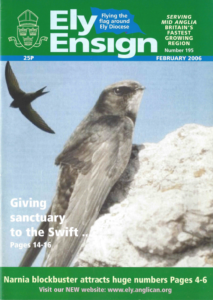
Four local churches have volunteered to become experimental nesting places in an attempt to save a breed of wild bird from extinction.
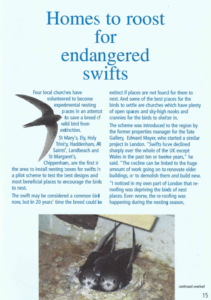
St Mary’s Ely, Holy Trinity, Haddenham, All Saint’s, Landbeach and St Margaret’s, Chippenham, are the first in the area to install nesting boxes for swifts in a pilot scheme to rest the best designs and most beneficial places to encourage the birds to nest.
The swift may be considered a common bird now, but in 20 year’s time the breed could be extinct if places are not found for them to nest. And some of the best places for the birds to settle are churches which have plenty of open spaces and sky-high nooks and crannies for the birds to shelter in.
The scheme was introduced to the region by the former properties manager for the Tate Gallery, Edward Mayer, who started a similar project in London. “Swifts have declined sharply over the whole of the UK except Wales in the past ten or twelve years,” he said. “The decline can be linked to the huge amount of work going on to renovate older buildings, or to demolish them and build new.
“I noticed in my own part of London that re-reroofing was depriving the birds of nest places. Even worse, the re-roofing was happening during the nesting season, destroying the occupied nests.”
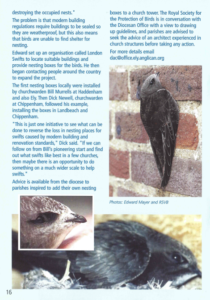
The problem is that modern building regulations require buildings to be sealed so they are weatherproof, but this also means that birds are unable to find shelter for nesting.”
Edward set up an organisation called London Swifts to locate suitable buildings and provide nesting boxes for the birds. He then began contacting people around the country to expand the project.
The first nesting boxes locally were installed by churchwarden Bill Murrells at Haddenham and also Ely. Then Dick Newell, churchwarden at Chippenham, followed his example, installing the boxes in Landbeach and Chippenham.
“This is just one initiative to see what can be done to reverse the loss in nesting places for swifts caused by modern building and renovation standards,” Dick said. “If we can follow on from Bill’s pioneering start and find out what swifts like best in a few churches, then maybe there is an opportunity to do something on a much wider scale to help swifts.”
Advice is available from the diocese to parishes inspired to add their own nesting boxes to a church tower. The Royal Society for the Protection of Birds is in conversation with the Diocesan Office with a view to drawing up guidelines, and parishes are advised to seek the advice of an architect experienced in church structures before taking any action.
The Common Swift (Apus apus)
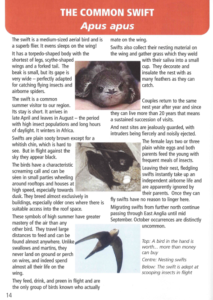
The swift is a medium-sized aerial bird and is a superb flier. It even sleeps on the wing!
It has a torpedo-shaped body with the shortest of legs, scythe-shaped wings and a forked tail. The beak is small, but its gape is very wide – perfectly adapted for catching flying insects and airborne spiders.
The swift is a common summer visitor to our region. Its stay is short. It arrives in late April and leaves in August – the period with high insect populations and long hours of daylight. It winters in Africa.
Swifts are plain sooty brown except for a whitish chin, which is hard to see. But in flight against the sky they appear black.
The birds have a characteristic screaming call and can be seen in small parties wheeling around rooftops and houses at high speed, especially towards dusk. They breed almost exclusively in buildings, especially older ones where there is suitable access into the roof space.
These symbols of high summer have greater mastery of the air than any other bird. They travel large distances to feed and can be found almost anywhere. Unlike swallows and martins, they never land on ground or perch on wires, and indeed spend almost all their life on the wing.
They feed, drink and preen in flight and are the only group of birds known who actually mate on the wing.
Swifts also collect their nesting material on the wing and gather grass which they weld with their saliva into a small cup. They decorate and insulate the nest with as many feathers as they can catch.
Couples return to the same nest year after year and since they can live more than 20 years that means a sustained succession of visits.
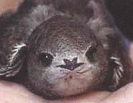 And nest sites are jealously guarded, with intruders being fiercely and noisily ejected.
And nest sites are jealously guarded, with intruders being fiercely and noisily ejected.
The female lays two or three plain white eggs and both parents feed the young with frequent meals of insects.
Leaving their nest, fledgling swifts instantly take up an independent airborne life and are apparently ignored by their parents. Once they can fly swifts have no reason to linger here.
Migrating swifts from further north continue passing through East Anglia until mid September. October occurrences are distinctly uncommon.
